Learn how to make blue ock candy inspired by Breaking Bad. It’s easier than you think, and the results look AND taste delicious. Perfect for costume and viewing parties!
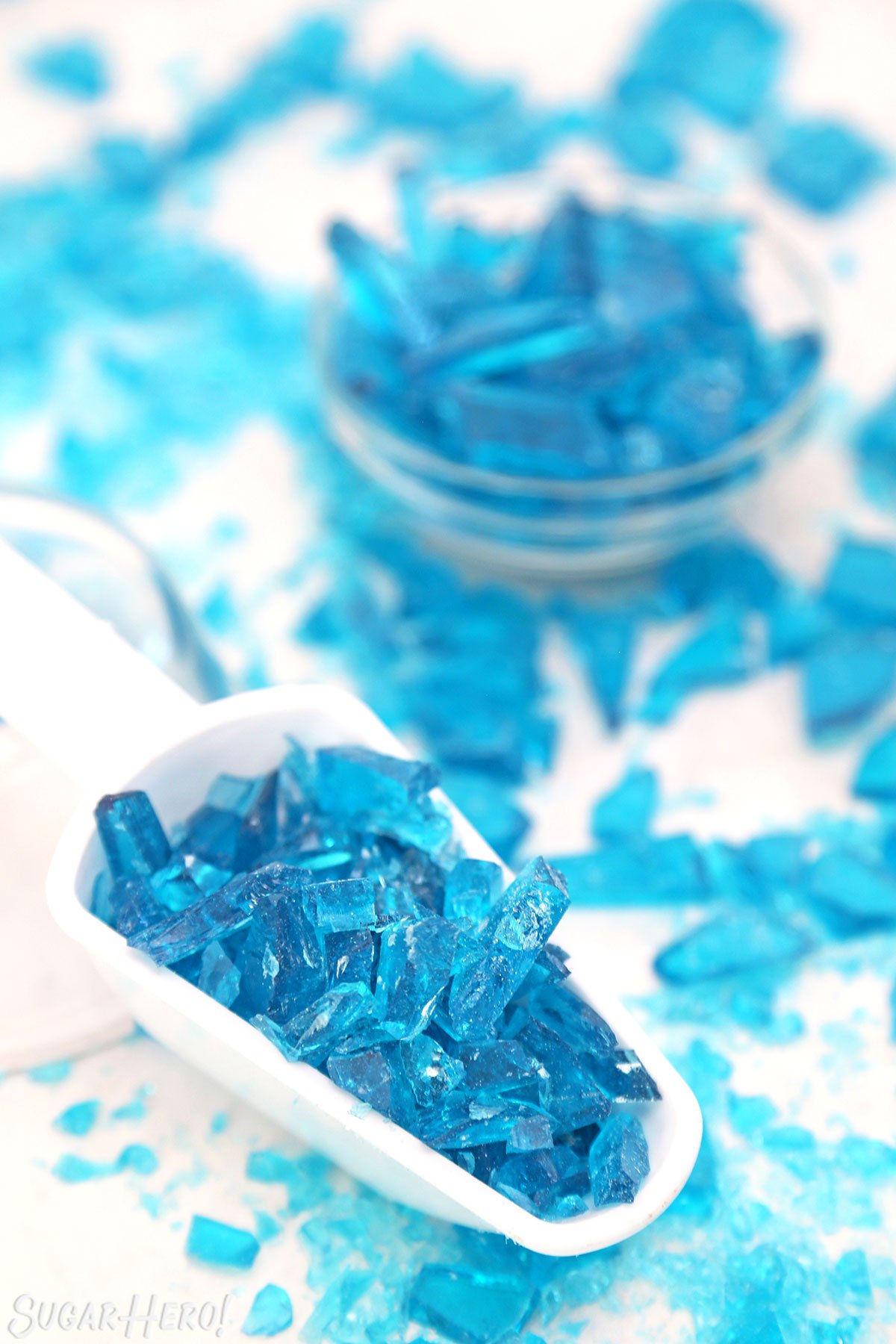
💙 How to Make Blue Rock Candy
This rock candy recipe is inspired by the television show Breaking Bad. As any viewer knows, the plot revolves around the blue-tinged crystal meth created by chemistry teacher Walter White and his student-turned-partner Jesse Pinkman. The meth is so pure, so potent, that it changes the entire southwestern drug trade and, eventually, the very lives of its creators.
As a fan of both sugar and television, imagine my delight when I found out that the “meth” used in the show is actually rock candy. Too perfect! So way back in 2012, at the height of Breaking Bad mania, I decided to create my own rock candy recipe, modeled after the Breaking Bad drug, for a viewing party with friends. Since it was first posted a decade ago, hundreds of people have made it for parties and Halloween costumes. Here is just a small sampling of the readers who have made it, loved it, and sent in pictures:

Although Breaking Bad is now off the air, this recipe remains a popular one, so it seemed overdue for an update. I’ve revised the post and recipe to make it more thorough, detailed, and helpful for YOU, my budding little Heisenbergs!
😎 How to rock your candy-making
Rock candy is not difficult to make, and even beginning candy makers can do it successfully on their first try. Here are a few things you can do to ensure success:
- Read the recipe before beginning. This might sound obvious, but you’d be surprised! Once the candy hits a certain temperature things move very fast, and you want to be prepared to act right away, not be stuck reading the next step.
- Use a candy thermometer. More on this below, but it is the #1 tool that will guarantee you success.
- Read the Tips & Troubleshooting sections right before the recipe. Overwhelmingly, when people have trouble with this recipe, it is caused by a few very common mistakes, and knowing what these are in advance will help you avoid them.
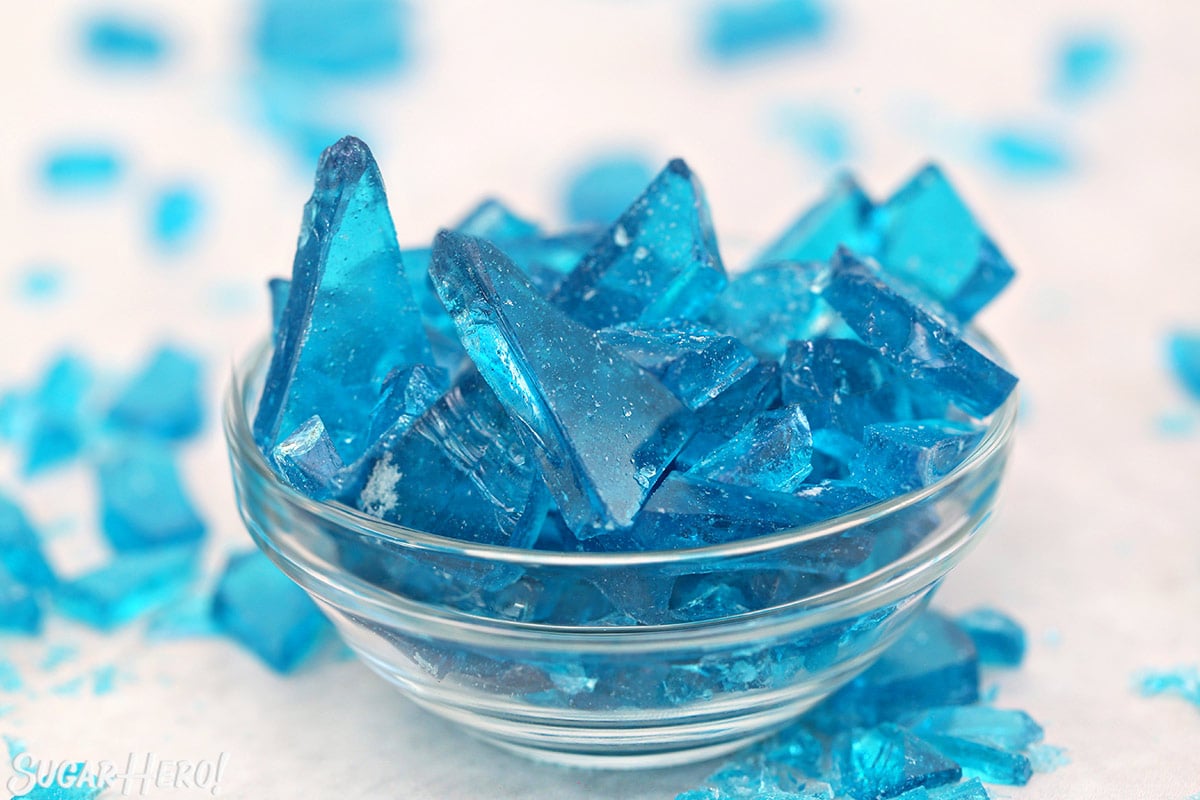
Table of Contents
🧾 What You’ll Need
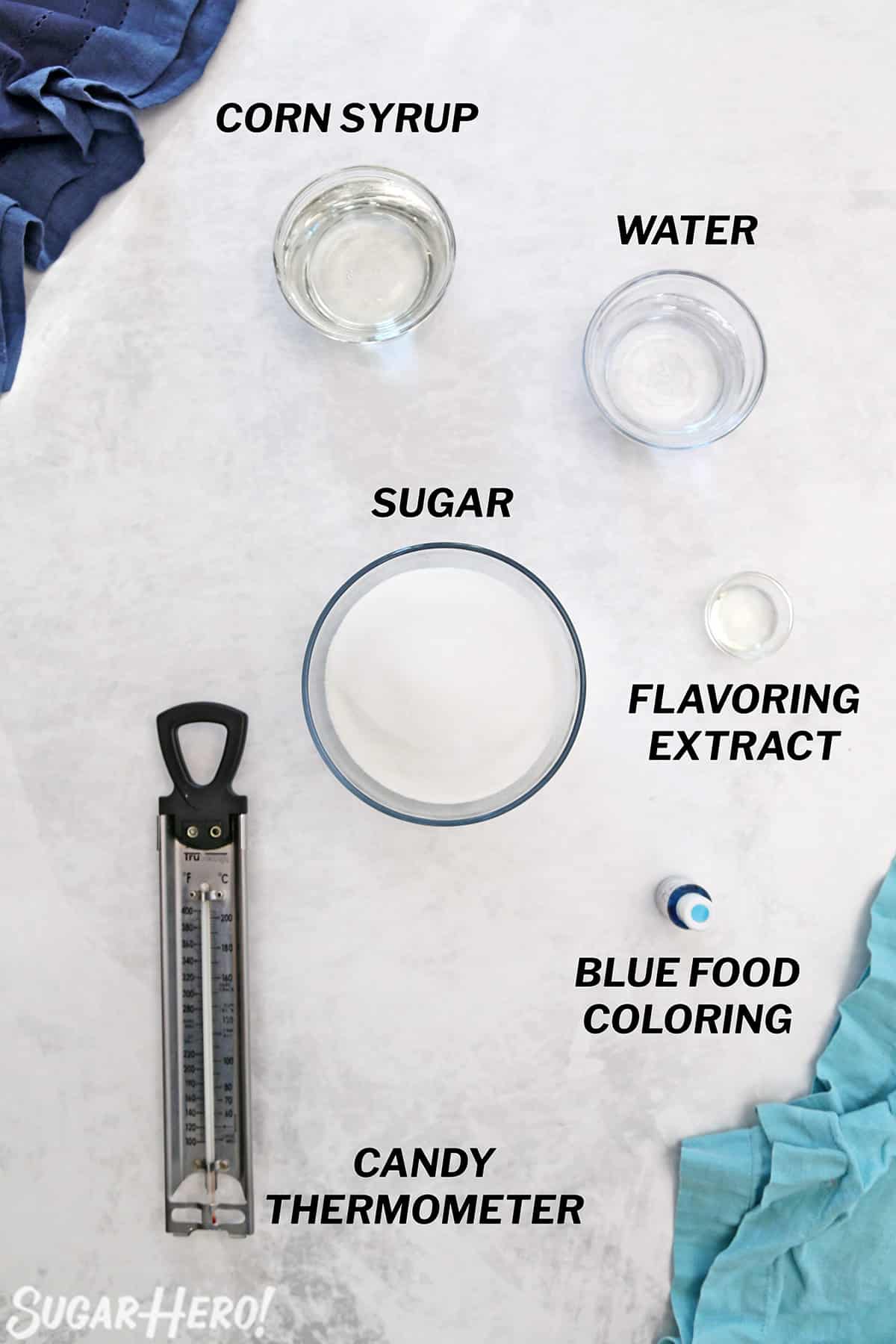
Ingredients & Equipment
Here’s what you need to know as you gather your candy-making supplies. (Links are affiliate links and I earn a small commission from qualifying purchases.)
- Corn syrup: Light corn syrup helps prevent the sugar from crystallizing. If you are not able to easily find it, golden syrup or glucose syrup is a good substitute. Note that golden syrup has a yellow tinge and is likely to turn your finished candy greenish-blue.
- Granulated sugar: Not all sugar is created equal. Some granulated sugar is made from cane sugar, and some comes from beets. My strong preference is to use 100% cane sugar — in my experience, this gives more reliable, consistent results. If your sugar package does not specify, chances are that it is beet sugar or a mix of both.
- Clear flavoring extract: If getting a blue color, like on the show, is important to you, you’ll want to be sure you’re using clear flavoring extract. Brown extracts like vanilla will give your candy a yellowish tinge. See the Flavoring section below for a list of clear flavoring suggestions.
- Blue gel food coloring: I always make my candy with Americolor Sky Blue gel coloring, and feel confident recommending this brand and color. Liquid food coloring (ie, the type found in most grocery stores) might not produce the color results you’re after.
- Candy thermometer Not optional! A candy thermometer is the #1 tool you will need to make perfect rock candy. You can buy an inexpensive one from the grocery store (like this model). If you will be making candy regularly, it’s worth it to invest in a nicer thermometer. I have and love the ChefAlarm, because it alerts me when I’m nearing my finished temperature.
Pro Candy-Making Thermometer Tips
- If you are just getting started with candy making, check out this step-by-step guide for How to Use A Candy Thermometer. It’s filled with pro tips to help you get started.
- For those of you who already own a candy thermometer, take the time to do some maintenance! Learn How to Test and Calibrate a Thermometer so that your candy thermometer will be functioning at its best.
- Finally, environment can impact the way your candy thermometer reads. For those who live above sea level, take the time to review some Essential Tips & Techniques for Candy Making at High Altitude.
📋 How to Make Rock Candy
Here’s an overview of how to make this blue rock candy, and full instructions are included in the recipe card down below.
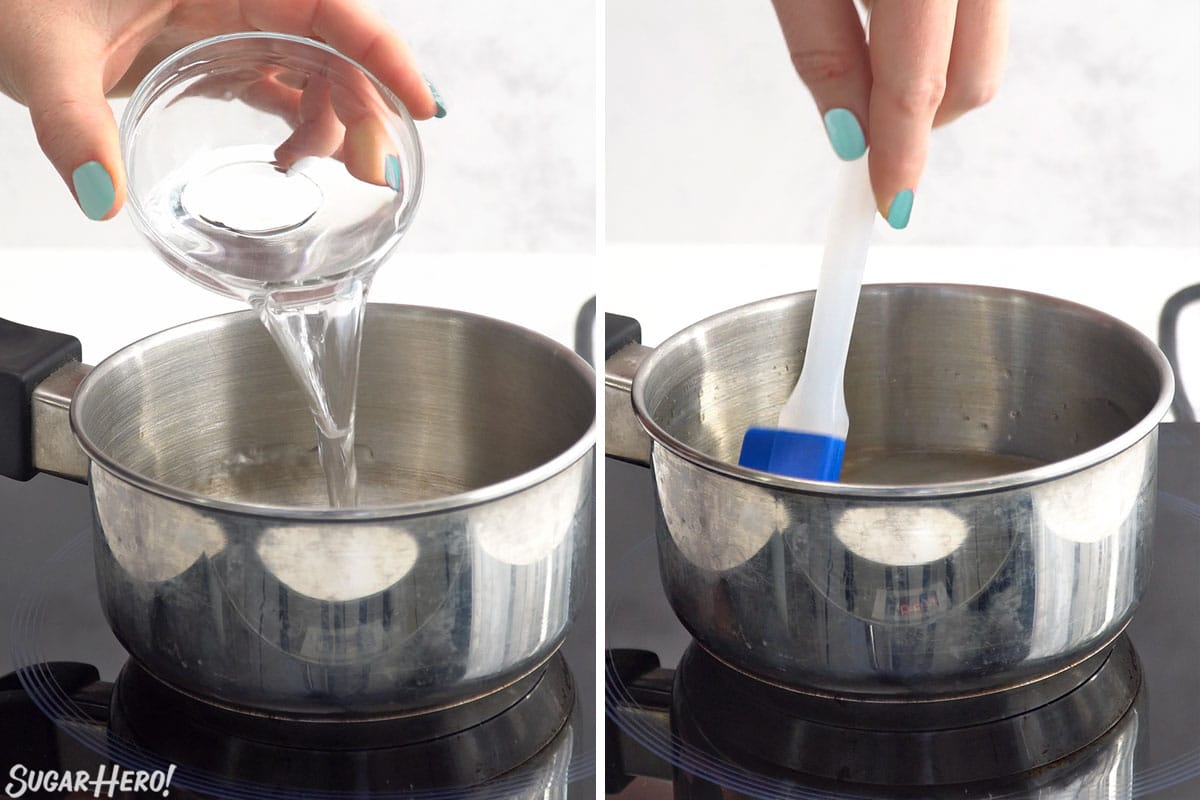
Make the sugar syrup
- Combine water, light corn syrup, and granulated sugar in a medium saucepan over medium-high heat.
- Stir until the sugar is moistened and dissolves.

- Brush down the sides of the pan with a wet pastry brush – this will remove any stray sugar crystals. Sugar crystals in the pan can cause your whole batch to crystallize.
- Once it comes to a boil, insert a candy thermometer. From this point on, do not stir the candy.
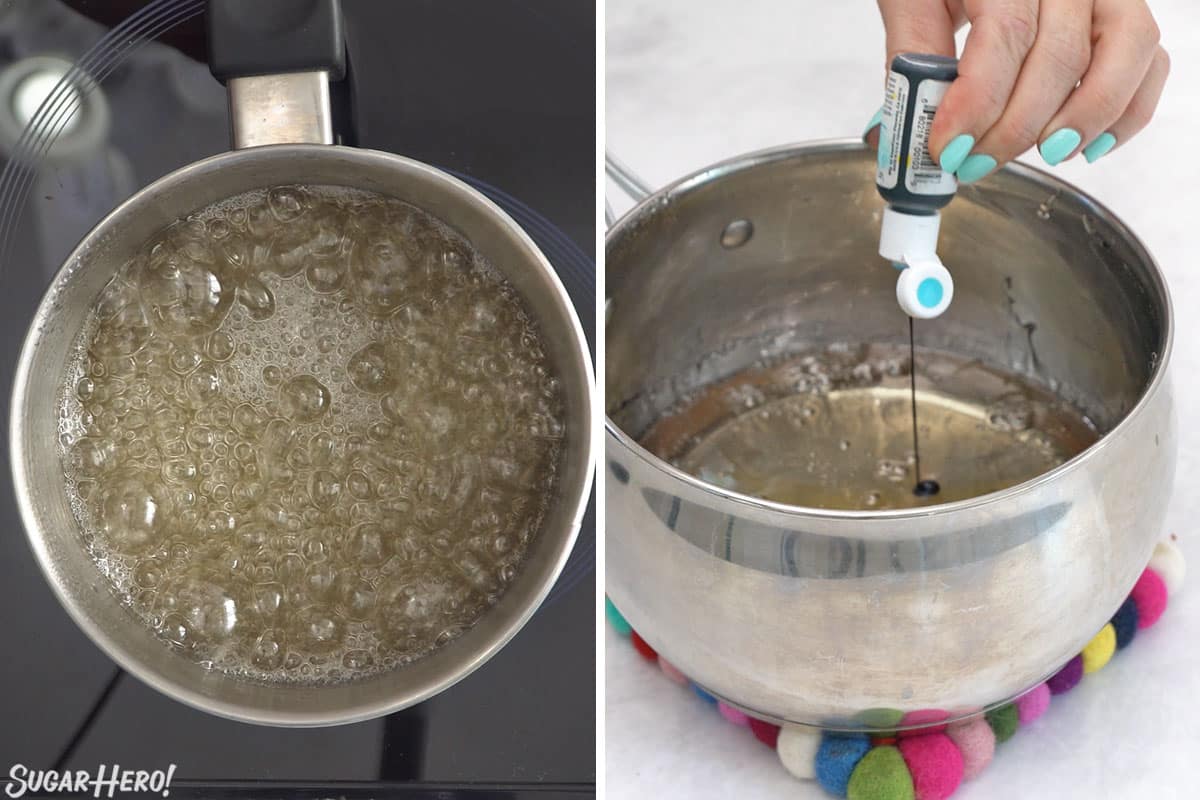
Cook and add coloring
- Cook the candy until it reaches 290 F on the thermometer. It should be a light yellowish color.
- Immediately remove the pan from the heat. Let it sit for a minute, until the rapid bubbling stops, then add flavoring extract and blue gel food coloring.
- Stir well until the color is evenly distributed.
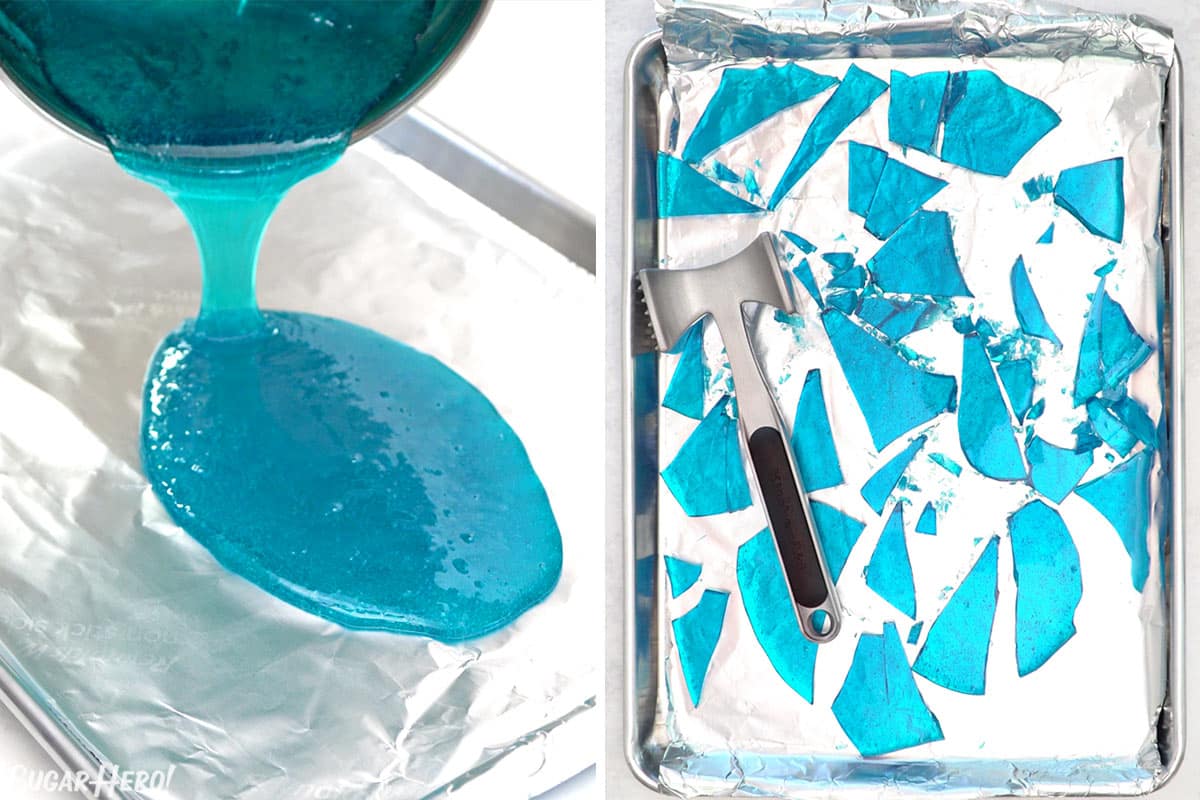
Pour and cool
- Pour the hot candy out onto a baking sheet covered with foil. You can spread it into a thinner layer with the spatula if you’d like.
- Let the candy cool completely at room temperature, until it is set and hard.
- Use a knife or kitchen mallet to smash it up into smaller pieces.
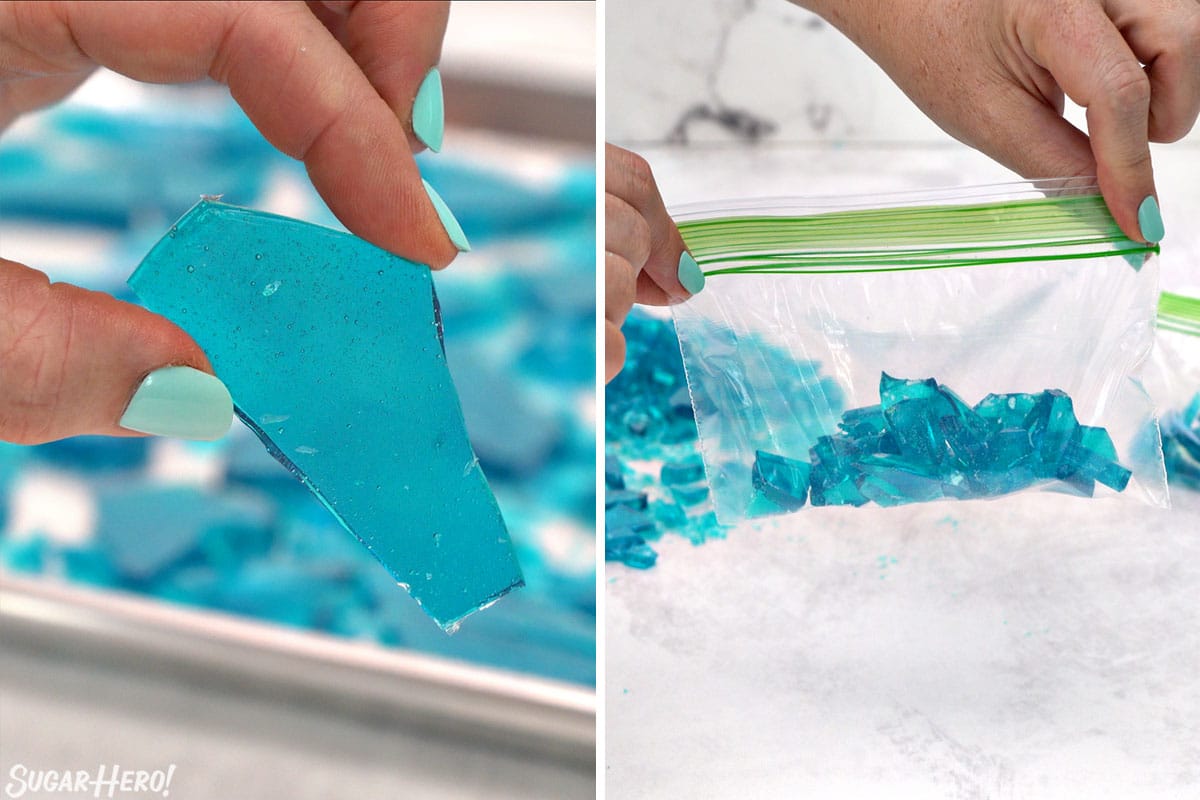
- This candy is easiest to eat in large pieces, so some people prefer to leave it in big chunks. If you want to be more accurate to the show, you can crush it up into smaller chunks.
- For optimal awesomeness, I recommend serving this in small baggies at a Breaking Bad viewing party.
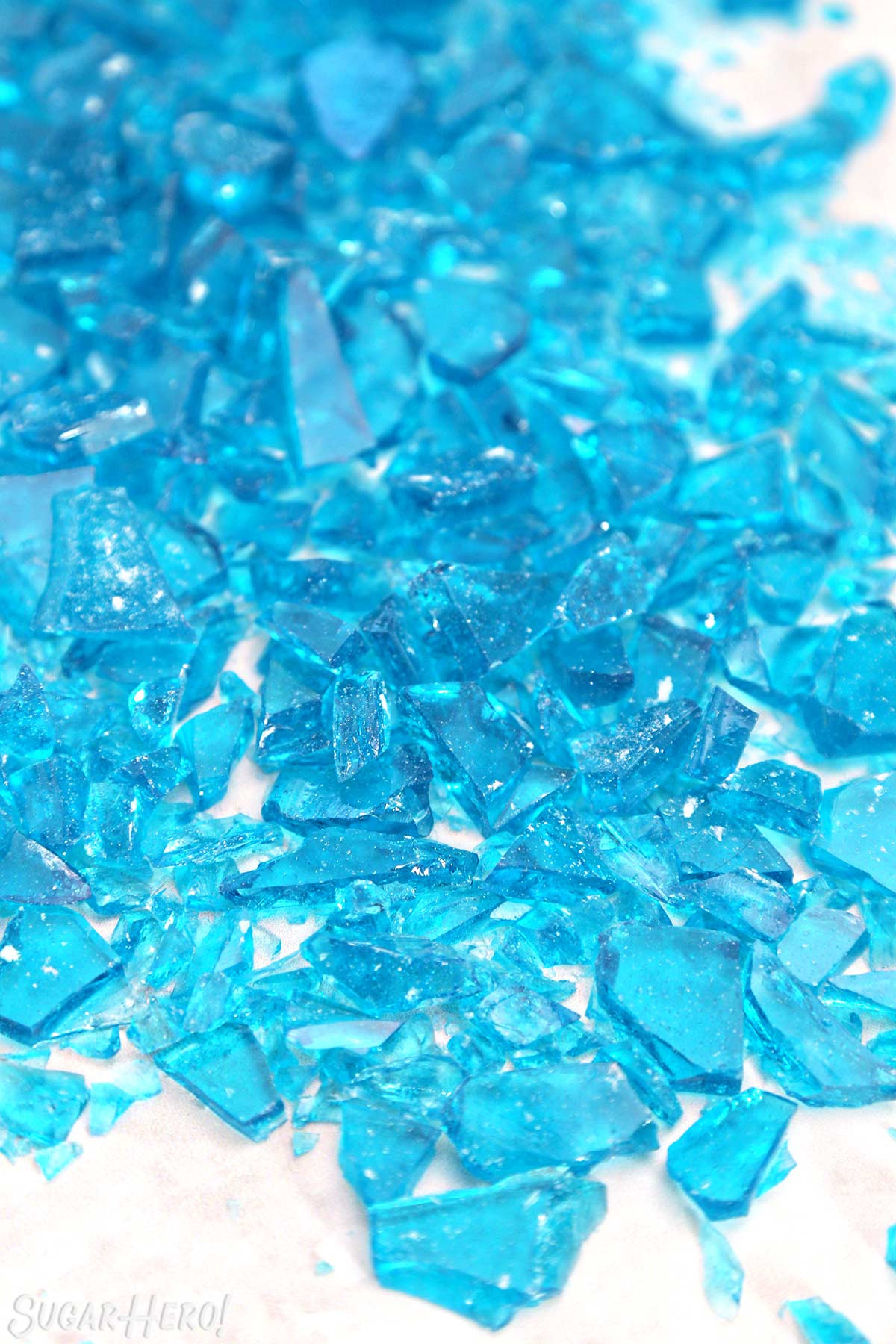
😋 Flavoring Recommendations
Clear flavoring is a must if you want your candy to stay clear and blue. You can always use clear vanilla, which is often available at cake and candy supply stores, and some larger grocery stores. It is imitation vanilla, so the flavor isn’t as great as real vanilla extract, but if you want vanilla candy, it’s your best bet.
My personal favorite is fruit flavors, since it seems like such a natural choice for hard candy. Here’s a partial list of clear candy flavorings. I like LorAnn because I think the quality, consistency, and flavors are great, but you can of course use any clear flavoring or extract brand that you like. Many of the larger LorAnn bottles are tinted so you can’t tell the color inside, but most of the 1-dram bottles are clear, so you can either view them online to check the color, or order them as an experiment before committing to a larger bottle.
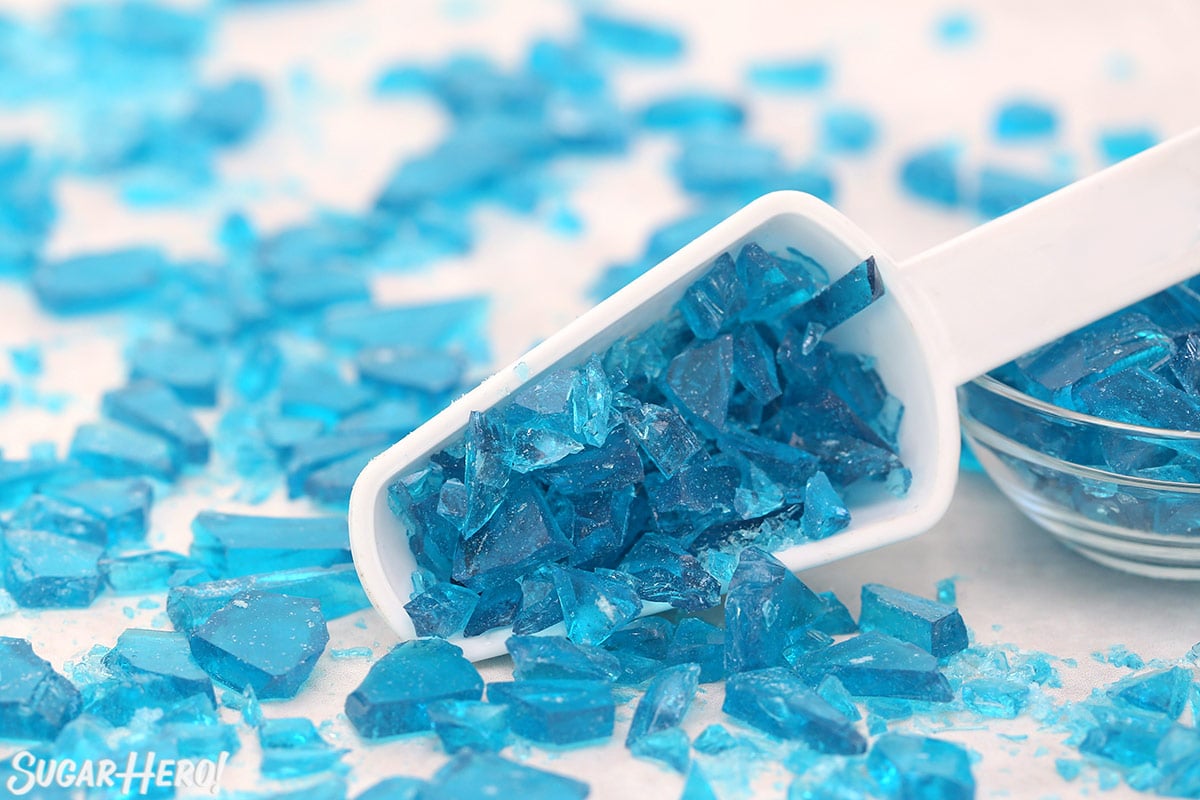
💡 Tips
Safely working with hot sugar
Hot sugar can be extremely dangerous — the temperature gets very high (290° F in this recipe!) and because it is a thick and sticky substance, if you accidentally get some on your skin, it doesn’t rinse off quickly, which can lead to serious burns.
Because of this, this is not a good recipe to make with smaller children. It’s also a good idea to have a bowl of ice water handy while the sugar syrup is cooking, so if you’re accidentally burned, you can immediately dunk your hand and stop further burning. And as always, be alert, deliberate, and careful with your movements in the kitchen.
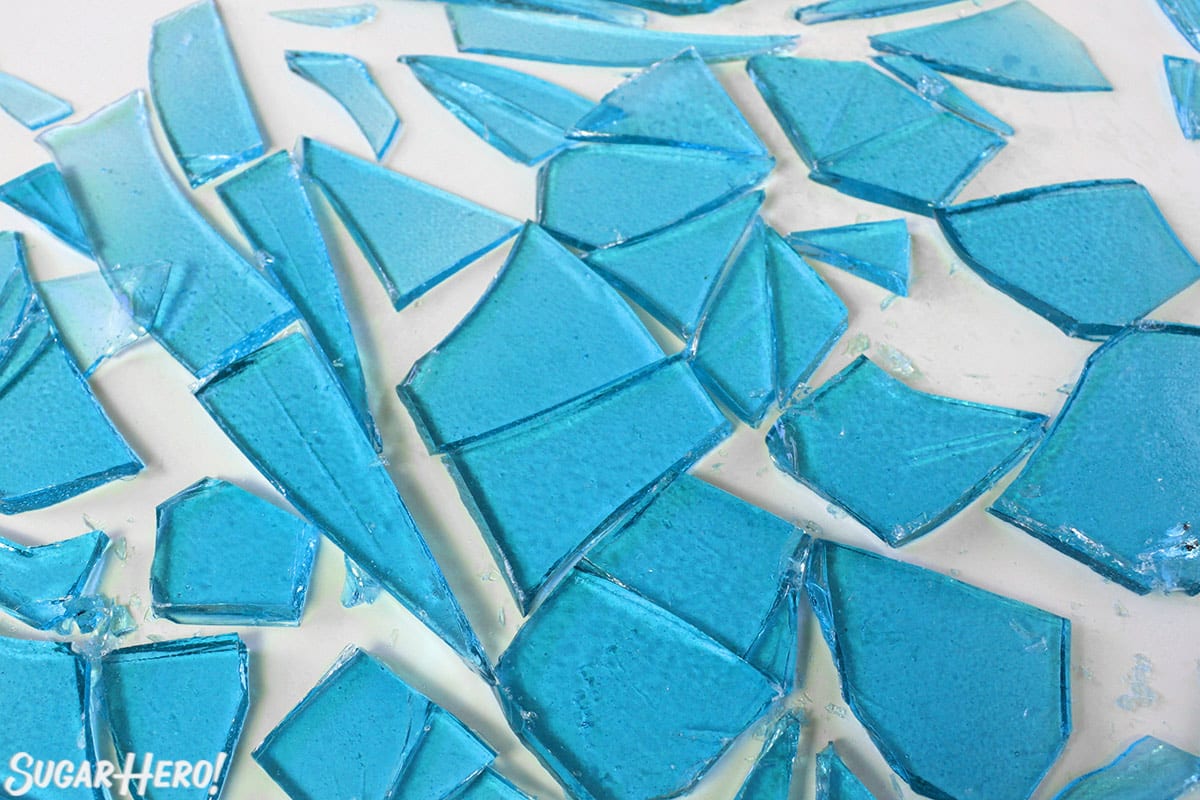
Testing your candy thermometer
It’s important to regularly test your candy thermometer for accuracy. Testing is especially important if you live at a higher altitude, but even at sea level, thermometers can become inaccurate over time. Having an accurate thermometer is essential to successful candy-making.
To test your thermometer, bring a pot of water to a boil, insert the candy thermometer for a minute, and then take a reading. At sea level, water boils at 212° F. If your thermometer doesn’t show 212°, calculate what the difference is. For example, if your thermometer reads 208° in boiling water, you know that you have a difference of -4 degrees in your thermometer. Going forward, you should subtract 4 degrees from any temperature written so that yours is accurate. In this example, if something needs to be cooked to 300° F, you only need to cook it to 296° F on your thermometer to get the right result.
The secret to easy candy removal
This isn’t a necessity like a candy thermometer, but it is a tip that can make your life a little easier! When making hard candy, I like to cover my baking sheets with non-stick foil. Hard candy can be sticky and difficult to remove from regular foil, but non-stick foil is magic, and the candy peels right off!
Other alternatives are to use a silicone baking mat, or spray regular or heavy-duty foil with nonstick cooking spray before beginning.
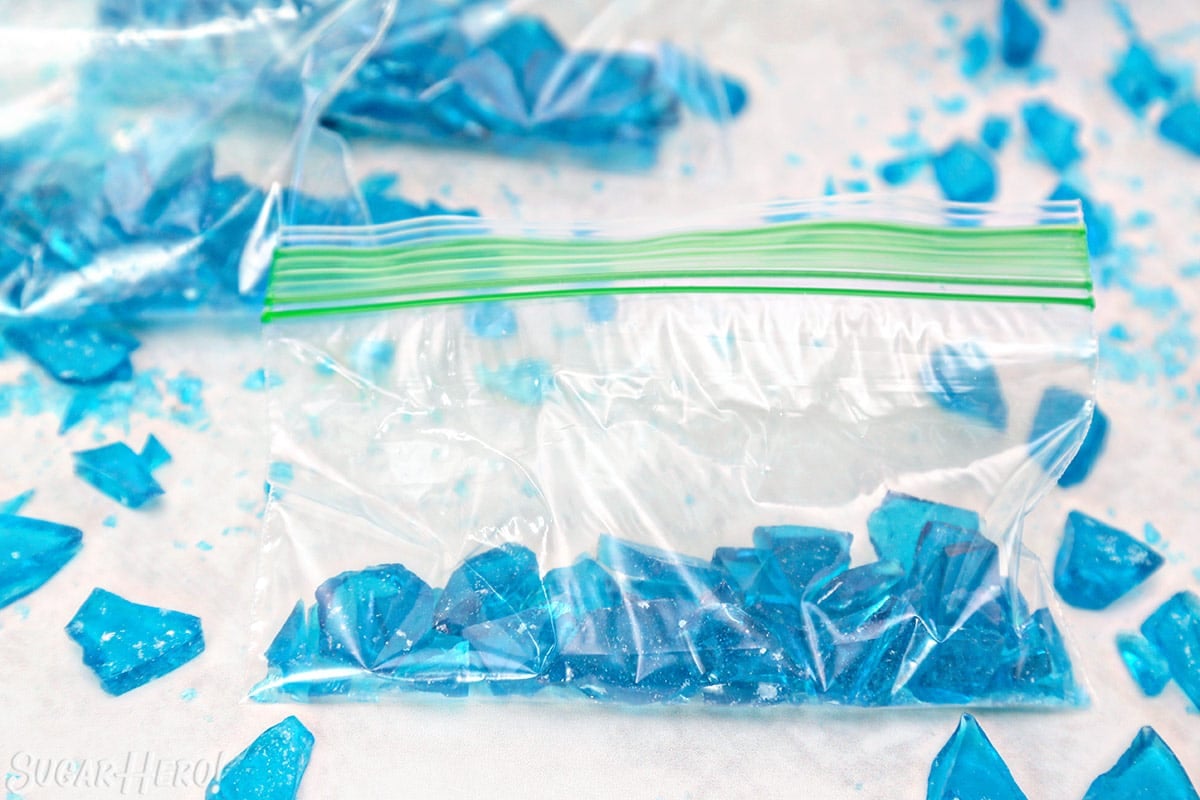
💡 Troubleshooting
Here are some common questions/difficulties people have had with this recipe, and my suggestions for how to prevent them.
This is the #1 problem people have with this recipe. There are 2 possible culprits: overcooking the candy, and using the wrong food coloring.
First, overcooking. The sugar syrup, if allowed to cook to a high temperature, will eventually turn yellow, then amber, then brown. This recipe calls for syrup to be cooked to 290 F, which should produce a near-colorless mixture that will not interfere with food coloring. (It will have a slight yellowish tinge.) If your candy is already a yellow or brown color when you’re adding the food coloring, chances are you have overcooked it, and the yellow color of the candy will mix with the blue dye and turn your candy green. The solution is to check to make sure your thermometer is accurate (see the Tips above) and to watch the candy like a hawk when it’s cooking.
Secondly, using the wrong food coloring. I have made this several times with Americolor Sky Blue, and have always had the color turn out well. I can’t guarantee other colors or brands will turn out the same. Liquid coloring, especially, can be weaker and can produce a greenish shade.
Here are a few colorings other readers have recommended: one reader says that the neon blue McCormick’s liquid food coloring produced a great blue color. She also recommends using a packet of Duncan Hines Frosting Creations in Cotton Candy, stirring it in at the very end and omitting any other flavoring and coloring. Another reader had great success with Adeco brand Electric Blue, and recommends using 5 drops for a great blue color.
If the candy is too soft or doesn’t set, it has not been cooked enough. This recipe really, truly should be measured using a candy thermometer, and if you are using one and still having problems with soft candy, test the accuracy of your thermometer, and double-check that you used the correct quantities and temperature the recipe calls for.
If the candy is initially fine but quickly becomes sticky, humidity is probably the problem. Hard candy works best in a dry environment–sugar soaks up moisture from the air around it, and hard candy quickly becomes wet and sticky in the humidity. Don’t attempt this candy on a humid or stormy day. It should always be stored in an airtight container at room temperature, to keep it as dry as possible. You can also buy silica gel packets to store with your candy to absorb moisture and keep it from becoming sticky.
If your candy is crumbly or sandy instead of hard and crunchy, or opaque instead of translucent, then it has crystallized during the cooking process. Nothing is wrong with it, and it will still taste fine, but the appearance and texture may not be what you want.
Crystallization happens when sugar crystals form during the cooking process. This can happen due to stirring too much while it cooks (once it comes to a boil, you should not be stirring it at all), or not wiping down the sides of the pan with a wet brush to remove the crystals, or just accidentally having stray crystals on the candy thermometer, spatula, or pan. The corn syrup in the recipe helps prevent crystals from forming, so if you substitute other ingredients for the corn syrup, you might find that crystallization is more likely.
This candy won’t spoil, but the texture will become softer and stickier over time. For the best results, store your candy in an airtight container at room temperature for several weeks. If you live in a humid climate, consider picking up some food-safe silica gel packets to store with the candy, to absorb moisture from the air and keep your candy fresh.

🍬 More Candies You’ll Love
Now that you’re a candy-making expert, put those skills to good use and try one of our other popular candy recipes!
Leave a Review!
If you make this recipe, let us know! Leave a ⭐️⭐️⭐️⭐️⭐️ rating on the recipe below, and leave a comment, take a photo and tag me on Instagram @elabau, or use #sugarhero on IG!
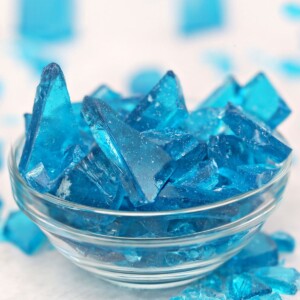
Breaking Bad Blue Rock Candy
Ingredients
- 1/2 cup water, (4 fl oz)
- 8.25 oz light corn syrup, (3/4 cup)
- 14 oz granulated sugar, (2 cups)
- 2 tsp clear flavoring extract
- blue gel food coloring, I used Americolor brand
- Candy thermometer
Instructions
- Line a baking sheet with foil and spray the foil with nonstick cooking spray, or use non-stick foil.
- In a medium saucepan, combine the water, corn syrup, and granulated sugar. Place the pan over medium-high heat, and stir until the sugar dissolves.
- Once it comes to a simmer, brush down the sides with a wet pastry brush to prevent sugar crystals from forming. Insert a candy thermometer.
- Continue to cook the candy without stirring until it reads 290 degrees Fahrenheit (143 C) on the thermometer. Watch the temperature carefully–a lower temperature might produce sticky candy, while a higher temperature runs the risk of producing green candy!
- Once at 290, take the pan off the heat and let it sit for a few moments, until rapid bubbles stop breaking on the surface. Add the flavoring and a drop or two of food coloring, and stir everything together.
- Pour the candy onto the prepared baking sheet and spread it into a thin layer. Let it set completely at room temperature.
- Once set, break it into small pieces. For the complete Breaking Bad experience, place the pieces in a large zip-top bag and smash them with a rolling pin until they are crushed, and place in small baggies to serve.
- Store the candy in an airtight container at room temperature.
Video
Measuring Tips
Our recipes are developed using weight measurements, and we highly recommend using a kitchen scale for baking whenever possible. However, if you prefer to use cups, volume measurements are provided as well. PLEASE NOTE: the adage “8 oz = 1 cup” is NOT true when speaking about weight, so don’t be concerned if the measurements don’t fit this formula.
Want to learn more about baking measurements and conversion?
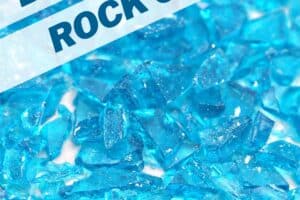
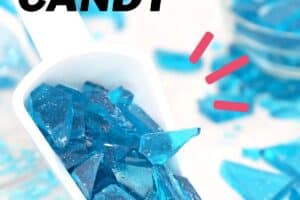
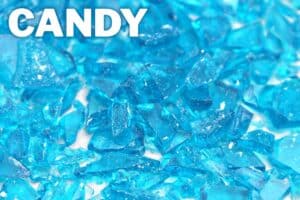

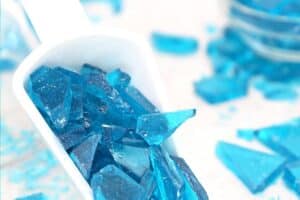
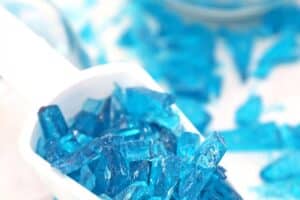

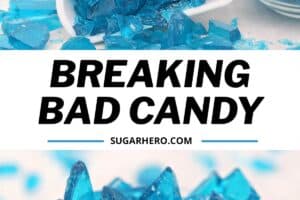
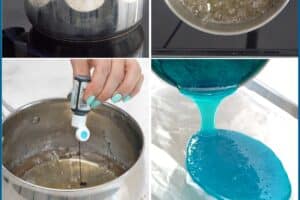
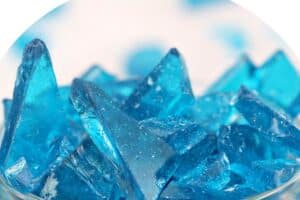
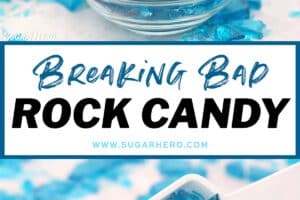
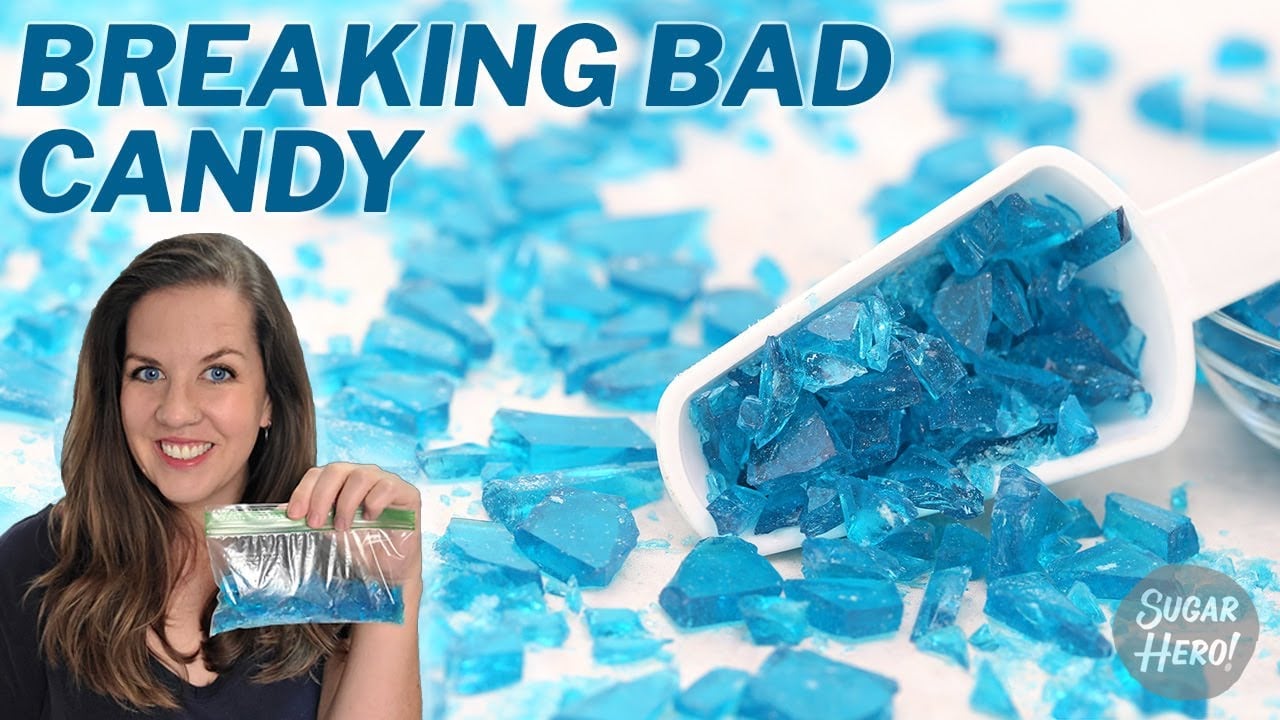
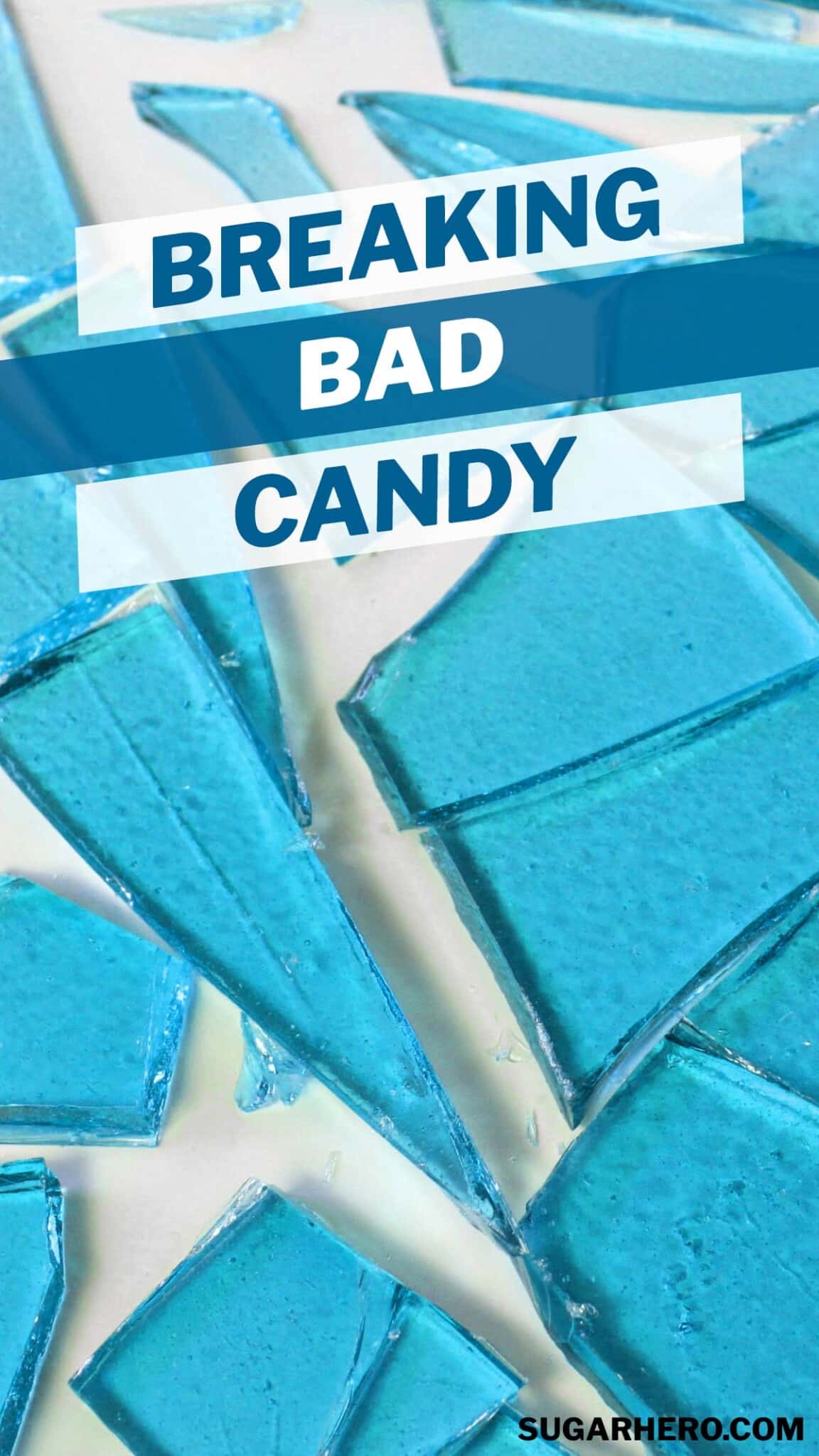
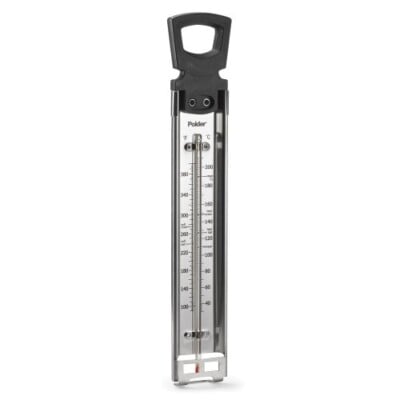
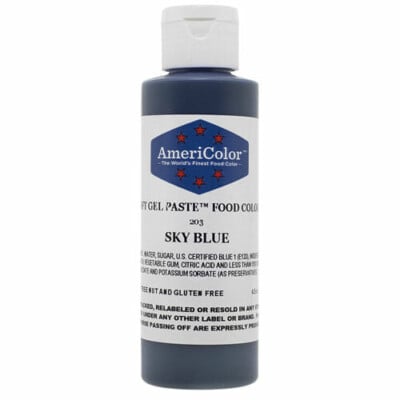
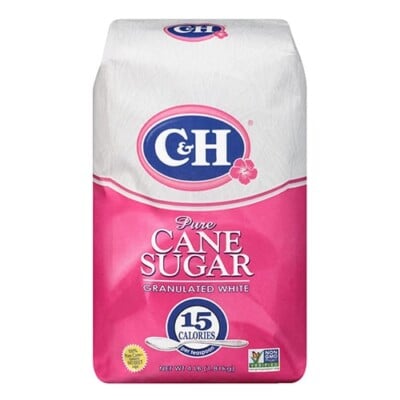
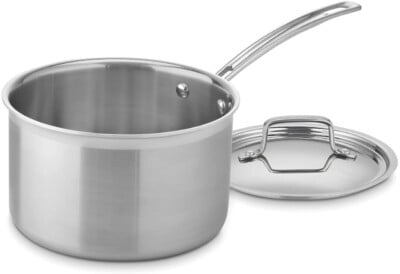

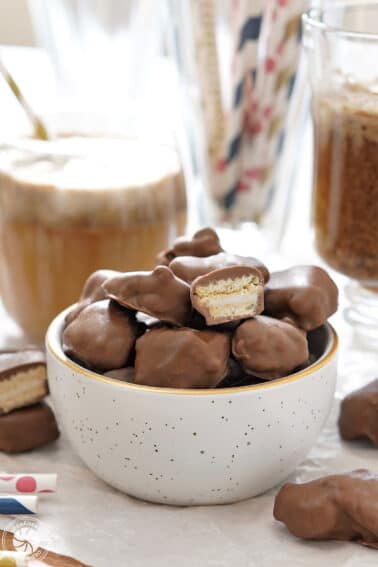














This recipe works really well! I did some experimentation with it because I was trying to do it without corn syrup, but my attempts failed – corn syrup is definitely the way to go!
Oh my goodness – being a HUGE breaking bad fan myself and seeing as to how the premiere of the final season is this weekend, this is the BEST THING EVER!!
after a few attempts i had to refine the recipe, at 285 degrees i found my candy wouldn’t crystalize, turns out that it actually needs to be 300-310 degrees in order to do so. but in order to avoid overcooking (as it is quite a finite temperature range) when taking the pan off the boil, i had to sit it in a bowl of cold water to cool the pan down and stop the cooking process as residual heat from the pan can continue to cook the candy and potentially overcook it, which then turns it green when adding the blue colouring.
thanks for the recipe though, i now have a new addiciton, but at leasts it’s one i can cook myself 🙂
Hi Rob, Glad you got the recipe to work! My original recipe called for the candy to be cooked to 300 (typical hard candy temperature) but so many people had trouble overcooking it and turning their candy green, I lowered my recommendation. Cooling the pan in a water bath right after cooking is a great call. Walter would be proud! 🙂
I’ll give this a try. Just cooked my first batch and although the look is spot on it was very sticky and nearly pulled a few teeth out! I thought this may be due to the substitutes I was using (had to use glucose as no corn syrup in the UK), but I’ll try cooking to 300* next time. Should this make it less sticky?
Yes, a higher cooking temp should definitely help! Glucose is a great substitute for corn syrup, so I don’t think it’s your ingredients–my guess is that adding a few degrees of cooking temp will solve the problem. Please let me know how it goes!
PS Your user name is cracking me up. I thought Walt Jr’s friend is named breakfast?
I just cooked the second batch at 300 and although it is less sticky, its still liable to pull a few teeth out. Could this be the ingredients possibly; I have been using blue food colouring oil instead of the gel, and 1-2 teaspoons of flavouring, as our stuff might not be as potent as you guys have in the US. Could it be that this extra liquid causes it to set less hard, or do I dare cook up until 310* like a few other recipes suggest?
That’s disappointing! 300F should be golden. I suppose it could be the change in ingredients, although if you would have asked I would have thought a small change like that wouldn’t make a big difference. Is it humid/stormy/rainy where you are right now? That could do it. You can definitely cook it higher–the risk is that the sugar will start to take on color and your candy will be greenish. But as far as taste and texture, you can safely take it to 310 or even 315. (Much past that, though, and you’re starting to caramelize the sugar, and while that’s delicious, it’s not really what we’re going for.) Another thought: have you tested your candy thermometer for accuracy? It’s as easy as sticking it in a pot of boiling water, but it’s a good way to know if your thermometer is off by a few degrees, which can make a big difference. Here are full instructions:
http://candy.about.com/od/candybasics/ht/How-To-Test-Your-Candy-Thermometer.htm
Two thumbs up for Cpt Crunch! Eagerly awaiting tales of your candy success and a new clever user name.
I made a batch using your recipe and instructions and it came out flawlessly! I may have overcooked it a little and used too much food coloring, but otherwise it was perfect, and quite tasty. I used 4 drops of the McCormick Neon Blue food coloring and mint extract. I sent this to a friend who is also a huge BB fan with a letter from “W.W.” and he got a kick out of it! Thank you!
Awesome! So glad to hear it worked well with the Neon Blue–and I’ll bet your friend loved the message from “Walt.” 🙂 That’s great!
Blew up my moms glass measuring bowl and spent two hours cleaning shards of glass out of the corn syrup. Cut my feet and burned my hand. My parents were horrified. Luckily I got everything swept up and washed down. DO NOT USE GLASS… :/
General rule of thumb is that kitchen glass, unless specified otherwise, can handle boiling water max. Anything hotter than that and it’s gonna crack or, in worse scenarios, shatter.
Can you just use regular syrup?
Hi Anthony, I’m not sure what you mean by regular syrup–maple-flavored pancake syrup? I haven’t tried it but I wouldn’t recommend it. The brown coloring would make your candy a dark color, and the composition/other additives in the syrup might mess up the cooking. If you do end up giving it a try, please let us know how it turns out!
I used to love making this in high school back in the 80’s. My Mom and I had all sorts of flavors and colors. In any case, time moves on and thanks to YOUR wonderful recipe, I’m making it again!
I made my first batch last night. It wasn’t quite up to Heisenburg standards … but it was a nice first attempt. Next time I need to get it a few degrees hotter. It cracked just fine … but it gets a bit chewy once it’s in the mouth.
I used the cotton candy flavored packet of frosting creations. It has a nice taste and the color is alright. My one warning to anyone going this route, once you take the candy off the heat and wait for the bubbles to stop, stir in the flavoring VERY well. I didn’t mix it well enough so there were dozens of small dark blue “dots” of mix in the candy. It’s not horrible? I just laughed thinking of Walt yelling, “It’s not pure!” haha
Thanks again for the GREAT recipe and tips! I have a picture up at my site and I’ll be making more today or tomorrow!
ThirtyWhat
That is awesome! Thanks for the feedback! I’ve never tried the frosting creations myself, only heard about it from readers, so it’s good to know what works & what could be improved. Also, you can definitely take it a few degrees hotter–up to 300 F should be fine, provided you watch it toward the end so it doesn’t take on color.
Hey!
I just tried this but it didn’t set properly. It’s hard but not hard enough to smash. Its a bit sticky.
I used a thermometer and took it off the heat when it reached 285. I’ve left it set for an hour and just put it in the fridge 2 mins ago to see if that will help.
Any ideas??
Hi Nicole,
It sounds like the candy wasn’t cooked enough. Unfortunately if it’s not hard by now, it won’t get harder and refrigerating probably won’t help things. (The humidity in the fridge might just make it stickier.) If you’re up for trying it again, I’d first test your thermometer to make sure it’s accurate (how-to link below) and then cook it to 295 F this time–if you watch the temperature carefully you should be able to cook it to 295 and get it hard without risking the candy turning green. Good luck!
http://candy.about.com/od/candybasics/ht/How-To-Test-Your-Candy-Thermometer.htm
Yeah it’s currently stuck to my teeth! Looks awesome, but it’s too sticky.
Will be making another batch tomorrow.
Thanks again for posting this online and for replying!
Also Elizabeth, just a last question to ask, I had to use glucose syrup as we don’t have light corn syrup in Ireland.
Would this have anything to do with the sticky-factor?
If so, how much glucose syrup should I use in my second batch? It’s €5 ($7) per pot and it’s one pot per batch so it’s pricey! Would appreciate any advice.
Hi Nicole, I’m not exactly sure. I haven’t tried this particular recipe with glucose (it is much hard to find glucose than corn syrup here!) but I have made other hard candies with glucose instead of corn syrup, and it’s worked fine. My understanding is that glucose and corn syrup can be substituted on a 1:1 basis, so my guess is that it *should* work fine if you take it to a higher temp so more of the water boils off. That being said, I looked up a recipe for hard candy in an older candy book I have, and the recipe they use is 3 cups sugar, 3/4 cup glucose, and 1/2 cup water. So if you want to experiment you could try adding an extra cup of sugar, and see if the changed ratio of sugar:glucose helps the candy to set. (I do have to emphasize that I haven’t tried this recipe myself.) And again, I would take it to 295 F or even 300 F this time–but not higher, or the candy will start to take on color and you’ll have greenish meth. Also, if it’s stormy, rainy, or otherwise humid where you are, your candy might be soft and sticky, so it’s best to do it on a dry day!
Thank you so much!
So close to giving up! Tried it with the extra cup of sugar and cooking til 295 and its now green!
Waiting til it sets to see if its less sticky than last time.
The only thing I can think of is to cook with the 3 cups of sugar but only until 285.
After that I’m out of ideas!
Ugh, frustrating!! I wish I had glucose handy so I could give it a try and provide some concrete ideas. (I have to order it online, so there’s no chance of getting it anytime soon.) So sorry this has been such a pain. When you do succeed it will be sweet, sweet victory! And all those who don’t have access to corn syrup will owe you a big debt of gratitude for doing all of this glucose experimentation. 🙂
Haha, I can’t believe I’m still doing it.
Right to summarize for everyone, and hopefully it will be of some use to anyone who uses glucose!
Batch 1:
2 cups sugar
1/2 cup water
3/4 cup liquid glucose (PME)
2 tsp flavouring (LorAnn Key Lime)
1/4 tsp colouring paste (SugarFlair Colour)
Cooked until thermom hit 285F
Result: Too sticky, too blue, overpowering smell and taste
Batch 2:
3 cups sugar
1/2 cup water
3/4 cup glucose
1 tsp flavouring
Drop of colouring paste
Cooked until thermom hit 295/300F
Result: Great consistency (although a teeny tiny bit sticky but its basically pure sugar so that’s to be expected!) and great taste but green!!
Batch 3:
3 cups sugar
1/2 cup water
3/4 glucose
1 tsp flavouring
2 drops colouring
Cooked until thermom hit 285
Result: Blue, translucent, and good consistency! It’s the best I’ve ended up with so far!
I think I *might* try the original recipe (2 cups sugar) and cook until 290/295… when I buy more sugar! I’m all out!
A local bar is hosting a Breaking Bad finale party for charity and they’ve asked me for 30 bags (15g) which I have all packaged up and ready to go. There’s easily another 10 bags to be gotten out of the batch.
The only thing I’ve found is it got stickier quickly. I’m in my room with the fan on; smashing and spooning furiously!
Thanks Elizabeth for having the patience of a saint! ^_^
Nicole, you are my hero! Seriously, this is awesome. Thank you for doing the recipe testing for me when I could not. I am so glad that you got a batch you’re happy with!! (I was feeling guilty over the amount of glucose you were going through…) If you do end up trying a 4th version, please let me know how it goes! I’ll update the official recipe with a glucose variation once you settle on the one you like best. Do you feel like Walter White yet? SCIENCE!
P.S. I think it’s so great that you’re contributing these for charity!
I hope you will be able to answer to my questions on time 🙂
First of all, thank you for your fantastic sharing of ideas and recipes !
I’ve tried the recipe of the Crystal Meth Rock Candy, and here is the result: sticky and green…
So, knowing that if it’s sticky it means that it’s undercooked and if it’s green, it’s overcooked.. I am confused, I have to say.
I have used a gel food coloring, and as I do not have thermometer (yet!), and that I need the candy for tomorrow, I have used your advice given a bit further up to someone else, to test with iced water.
Do you have any idea what happened?
And what do I have to change?
I have enough to do one more batch, but that’s it !
Thank you so much,
a French-Irish fan x
Hi Benedicte, So sorry for the belated response–I imagine it’s too late to be of much help. It’s so hard to know what went wrong when I’m not in the kitchen with you, seeing how the candy is cooked and what ingredients are used. It’s especially difficult when you don’t have access to a thermometer, so we can’t troubleshoot and be precise about what temperature you’re cooking it to. If it’s soft and doesn’t break easily because it’s too soft and sticky, then yes, it’s undercooked. As to the green color, did you use light corn syrup, or did you substitute something else? Substituting some other syrups, like golden syrup, will give the candy a greenish color. Before you added the food coloring, was the candy colored at all in the pan–like a light yellow or amber color, or was it completely colorless?
Hi Elizabeth,
Thank you so much for your reply.
You are actually of a big help.
I’ve used Golden syrup, because it’s difficult in Ireland to find light corn syrup ! The candy was amber before I added the food coloring.
And I think that’s the issue here. I’ll buy myself a thermometer and I’ll try again with glucose probably.
My friend liked it even sticky and green… So no worries here, I’ll try again with every precise ingredients.
Thank you again for your help.
Take care.
Mystery solved! So glad we could figure it out–and that your friend liked soft green candy. 🙂
Glucose is a much better substitute in this case. I haven’t tried it myself, but other readers have. One did several test batches, and this is her recommendation for making this candy with glucose:
3 cups sugar
1/2 cup water
3/4 glucose
1 tsp flavouring
2 drops colouring
Cooked until thermom hit 285
Result: Blue, translucent, and good consistency! It’s the best I’ve ended up with so far!
If you do give it a try, please let me know how it turns out! When I get a little more feedback (or get my hands on some glucose–it’s hard to find here!) I’ll update the recipe with some alternative directions for those who can’t find corn syrup.
Will do I promise ! Thanks a million for your help !